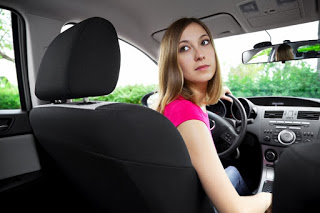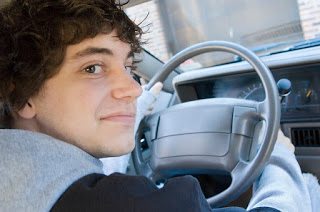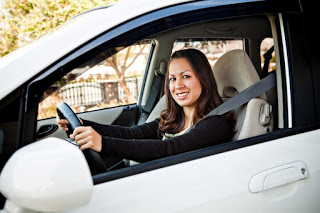
Phobias and Driving – The Fear of Driving
June 25, 2012
Fear can be a good thing. Fear is a natural survival response and it can be a healthy response when it leads us to avoid certain hazardous conditions such as; avoiding dangerous places, being on the lookout for dangerous animals when hiking in the forest, or not swimming in a rapid river where you can easily be swept away. Driving is one of those situations where a good, rational, healthy fear of a dangerous environment can lead a driver to exercise reasonable caution, obey the traffic laws, and be on the lookout for situations or aggressive drivers that could pose a danger.
However, there are times when rational fear gives way to irrational fears. An irrational fear or phobia, can lead to avoidance of any situation that could possibly put the phobic individual in a position where he or she may encounter their fear. Most of us experience one type of phobia or another to a lesser or greater degree. Fear of snakes, spiders, or heights all have their basis in a good, rational concern for safety but when that fear turns into a phobia it can cause the phobic individual to experience a panic attack and freeze up.
Phobias involving driving take several forms with some overlapping and some combining other, overriding phobias:
- Fear of Driving – Some individuals have an overwhelming fear of driving itself. This could be as a result of post traumatic stress after being involved in a collision or just a fear of being involved in a collision. For some, the fear results from a fear of open spaces or crowds (agoraphobia).
- Fear of Driving Over Bridges – Some individuals have a fear of bridges themselves (gephyrophobia) and, for others, it isn’t the bridge but the height of the bridge (acrophobia) that causes the fear. Some major bridges such as the Tappan Zee Bridge in New York and the Chesapeake Bay Bridge-Tunnel provide replacement drivers to drive over the bridge.
- Fear of Driving In Mountains – This fear results from a fear of landslides, fear of heights, and fear of losing control of the vehicle on steep grades.
Emotions play a big impact on our driving and, when a driver experiences a fear so great that it can lead to a panic attack the phobia can be extremely dangerous both to the phobic driver and to the other drivers on the road. At this point, the driver needs to consider help in overcoming the phobia by consulting a therapist. Some therapists specialize in overcoming phobias.
Some feel that self help programs work as effectively as counseling. There are books available and some phobics have experienced relief through deep breathing and other relaxation techniques. Analyzing the irrationality of the fear and replacing the imagined catastrophic events with the more typical, realistic results can also help.

Driving Lesson: Road Parking Tips
May 20, 2012
Parking is as much an important part of driving as driving itself. Learning how to park in different circumstances is an important part of the road test. The road test examiner may ask you to park in a parking lot space, to parallel park, or both. You need to know the proper procedures:
Signaling – Remember that you should signal your intentions at all times; even in a parking lot. Turn on your turn signal before you begin your turn into a parking space to let other drivers know what direction you are turning in. You should also signal as you exit the space to let other drivers know what direction you will be going in as you exit the space.
Parking lot– The examiner may point to a specific parking spot in the parking lot for you to park in. The spot may be lined on either side with orange cones to represent cars in the adjoining spaces. If you were to hit one of the cones, it will mean an automatic failure. Practice parking in a space by looking toward the center of the space before you begin your turn and keeping your eyes on the center of the space as you pull into the parking spot. Don’t look at the hazards on either side; look at where you want to put your car. Keep practicing until it is second nature.
Parallel parking – The examiner will point out a spot and ask you to demonstrate your ability to parallel park and, just like in the parking lot, there may be cones in front and back representing the bumpers of other cars; you don’t want to hit them. Parallel parking is really easy but it takes a lot of practice. Pull up even and about two to three feet away from the vehicle in front. Turn your wheel all the way to the right and slowly start to back up. As you come even with the rear bumper of the car next to you, start turning your wheel to the left. Once you enter the space, adjust your car so that it is parked an even distance between the car ahead and the one in the rear. You should be no more than eighteen inches from the curb.
Parking on a hill – The examiner may ask you to demonstrate or explain the procedures for parking on a hill with or without a curb.
- Downhill with or without a curb – Parking facing downhill is easy. Whether there is a curb or not, you should always turn the front wheels to the right so that, if your brakes should fail, the car will roll off of the roadway.
- Parking uphill without a curb – Parking facing uphill without a curb means you should turn your wheels to the right. Just like parking downhill, if your brakes should fail, the car will roll off of the roadway.
- Parking uphill with a curb – This is where it gets a little different. When parking facing uphill with a curb, you want to turn your front wheels to the left, toward the center of the road. Once you have turned your wheels, you will want to back up just a bit until you feel the wheels bump up against the curb. In this case, if your brakes should fail, the car’s front wheels should jam up against the curb and prevent the car from moving any further.
Parking properly is easy but it does take practice. Make sure you practice each maneuver until it becomes second nature to you before you take your road test.
Need extra practice? Take our behind the wheel road test course. It’s 100% online and shows you exactly what the examiner will be looking for.

Car Surfing and Riding Outside the Vehicle
May 11, 2012
Recently, news reports have told the story of at least five teens that were severely injured as a result of “car surfing”, or riding outside a vehicle.
In one incident, a 14 year old Georgia boy was riding in the trunk of a vehicle overloaded with teens. He was ejected from the vehicle and suffered severe brain injury. He remained in the intensive care unit for three weeks until he was taken off life support and died. The 19 year old driver is now facing charges in the incident.
In another incident from Georgia, a 16 year old boy skipped school with several others and was hanging outside an SUV traveling at a high rate of speed. The driver lost control and the SUV rolled crushing the teen underneath. At last report, he remains in a coma.
Two girls, one from Pennsylvania and another from Florida were injured while attempting to car-surf. Car surfing involves trying to remain upright or “surfing” on top of a moving vehicle. The Pennsylvania girl was taken to the hospital in critical condition. The Florida girl remains in a medically induced coma.
Another 17 year old boy was trying to hold down a mattress in the back of a pickup truck traveling at approximately 35 to 40 mph. The airstream, both above and below the mattress, created a wing-like effect, lifting the mattress along with the boy into the air. The boy died due to massive brain trauma.
Teens tend to feel invincible but no matter how strong, athletic or agile they may be, they will never be strong or agile enough to overcome the laws of physics. An object in motion tends to remain in motion in a straight line. That means that, while attempting to car-surf, if the vehicle should suddenly stop or turn, the “surfer” will continue traveling ahead at the same rate of speed, usually crashing into the pavement. Even at speeds as low as 10 to 15 mph, the results can be catastrophic.
Even inside the vehicle, if they aren’t wearing a seat belt, they are asking for trouble. Another recent incident involved a teen girl who was engaged in horseplay with her boyfriend while the vehicle was in motion. Authorities are unsure of what exactly happened but it is felt that the girl accidentally hit the door handle, opening the door. Not wearing a seat belt, she was thrown out of the vehicle and suffered traumatic brain injury.
Most of these incidents involved teens engaged in horseplay in or on a moving vehicle without a seat belt to hold them in place; most also involved cars driven by a teen with more than one other passenger. Graduated driving laws in most states usually restrict the number of passengers a teen can carry because it is well proven that, the more teen passengers a teen driver carries, the greater the distractions and the greater the temptation to show off.
Teens and adults need to be constantly reminded that there is no safe place on or in a vehicle except in a passenger seat securely buckled in with a seat belt.

Teen Emotions and Driving
May 5, 2012
Upset? Angry? Emotional? We all get that way. It is a natural part of life and sometimes a natural part of the day. Life and events are out of our control and so we all are thrown hurdles to get through; many times unexpectedly. Dealing with the emotions of what comes along can be complicated. But what you want to avoid is getting behind the wheel when you are emotional, angry or upset.
Many times people let their emotions get the best of them. When you are driving, you have to be able to give it your full attention. The attitude you have is your state of mind at any given moment, whether that be happy or sad, excited or full of anxiety.
Your state of mind controls how you behave and react to situations. The actions and reactions are a normal part of everyday living and interaction with others. When you are emotional behind the wheel, it can interfere with your ability to think clearly and inadvertently create a mental distraction.
For instance, if you are worried or upset or thinking through a complicated issue while driving, you may not notice your upcoming exit or turn, causing you to miss it or react suddenly. You become an inattentive driver. You may fail to scan the environment ahead or notice debris in the roadway. When you are angry or upset, you may increase your risk taking and pull out in front of another vehicle, cut someone off, or tailgate.
Positive emotions are dangerous too. Even when you’ve received the best of news there can be a lack of concentration when you get behind the wheel leading to increased reaction times. You can lose your ability to notice what other drivers are doing, anticipate their next moves and determine how you will respond.
Driving when emotions are high can interrupt your ability to process information in the driving environment and incite you to act out your emotions. You can lose your ability to perform skills that require precise timing to complete. Physically, your body can react in many ways including increases in heart beat and respiration rates and spikes adrenaline levels.
Teens’ brains are still developing and are very vulnerable to their emotions and the emotions of others. They usually have less means and independence than they would like, which can increase their frustrations and intensify their emotions.
So what do you do?
- Set a good example and choose not to drive when upset.
- Recognize the role emotions play when driving. Look at examples of other drivers on the roadway who maybe mental distracted and discuss the danger they pose together.
- Examine your and your teenager’s emotional make up and discuss coping strategies.
- Identify and predict situations that could cause both positive and negative emotions.
- Ask for a commitment from your teen to delay driving when they are emotional or upset. Get a verbal agreement and include it in your Parent & Teen Driving Contract.
What are some coping strategies?
- If you are excited or upset, ask someone else to drive you.
- Give yourself a few minutes and quiet your mind. Close your eyes and take a several deep breaths.
- Remember that you can’t control what happens to you, you can only control how you respond to it and many times that determines your ultimate success.
- Separate the actions, reactions and emotions from the people and the situations: John’s immature vs. John’s acting immature.
- If you can, take a short walk or do some quick exercises to settle your body down.
- Leave a few minutes early to give yourself extra time to get to your destination, so you won’t be hurried.
If you become upset while you are driving, pull over to a safe place. Take a few minutes, walk around, and breathe deeply. Avoid the risk and avoid the consequences…Drive with a safe attitude.
Learn more about the Facts Behind Teen Crashes.

Commit to Being a Safer Driver
April 10, 2012
Many people will make a commitment to losing weight, to do better in school, get out of debt, or join a fitness club. The sad part of making these resolutions is they are often very hard to keep and people often fail within the first few weeks or months of trying. One resolution that is easy to keep is to become a safer driver. It’s easy to achieve because licensed teenage drivers are in their vehicles every day giving them the opportunity to practice safe driving habits.
In today’s world of driving, drivers are trying to multitask behind the wheel with negative results. According to the Boston Focus Group Study of Bad Drivers:
- 77% of drivers admit to talking or texting while driving
- 60% admit to eating while driving
- 50% admit to making obscene or rude gestures or comments to other drivers, particularly those who cut in front of them
- 50% admit to almost falling asleep while behind the wheel
- Countless teens are getting behind the wheel of their vehicle drunk, high or buzzed.
Making a commitment to eliminate those types of activities from your daily driving habits isn’t hard to do. Let’s look at a few more:
- Ditch the cell phone because using a cell phone or texting while driving can be as dangerous or deadly as drunk driving. One way of doing this is to keep your cell phone far enough away that you will not be tempted to use it. Keep it turned off and let all messages go to voicemail. You can also purchase a cell phone blocker to block calls and/or texts while the vehicle is in motion. Only use a cell phone when driving for emergencies.
- Drive within the posted speed limit. When you speed you are increasing your chances of getting into a crash, injuring or killing yourself or others. Don’t be a follower and speed just because you think everyone else does. Be a leader and show others you obey the law.
- Fast food is often a teens lifeline but not while you are driving. If you need a snack, go into the restaurant or park and eat and then continue your journey.
- Always look when entering a lane of traffic or passing another car. Get into the habit of using your turn signals and side-view mirrors and don’t forget those inexpensive “blind-spot mirrors” can make the difference of getting into a crash or not.
- When someone cuts you off, take a deep breath, count to ten and let it go. Road rage accomplishes nothing except putting you in danger of a crash while you try to catch up to the other driver.
- Wear your seatbelt. Not because it’s the law, but because it will save your life.
- Study for your school tests at home, not while driving to school. Reading while driving is the second most common distraction while driving after the cell phone.
- Always remember drinking and drugged driving don’t mix. One beer even some over-the-counter medications can negatively impact your driving skills.
- If you plan on partying with alcohol, make sure you use a designated driver. Also remember that the drinking age is 21 in all 50 states.
- Finally, take a defensive driving course every couple of years. It’s always good to have a little refresher course and find out what changes have been made in the traffic laws and road conditions.
Make a commitment to become a smarter and safer driver. It is easy to incorporate into your daily living and will help you survive on the road. DRIVE SAFE!
